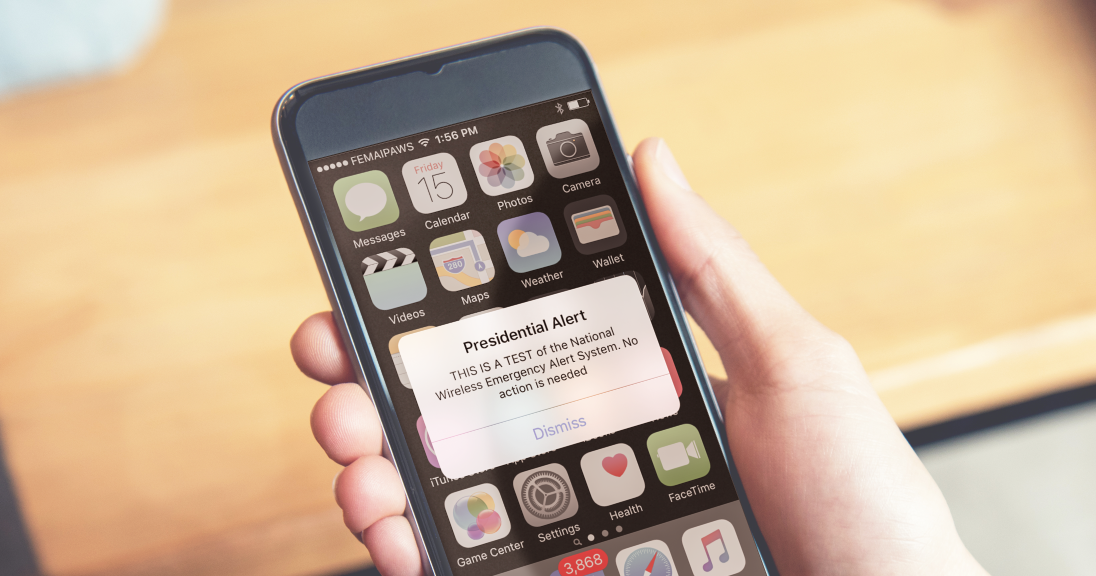FEMA will test its National Wireless Emergency Alert system on Wednesday. Here’s what that means

On Wednesday, Oct. 3, somewhat after 2 pm Eastern Daylight Time, mobile phone users across the United States will receive a “Presidential Alert.”
“THIS IS A TEST of the National Wireless Emergency Alert System,” the text of the message will read. “No action is needed.”

What Wednesday’s test will look like. (Courtesy of FEMA)
Contrary to what the text might lead you to believe, it’s not actually a message from President Trump. Rather, it’s the first time that the Federal Emergency Management Agency (FEMA) is testing its Wireless Emergency Alerts (WEA) system on a national scale. The WEA test will coincide with a nationwide Emergency Alert System (EAS) test sent over broadcast, cable and satellite. Wednesday marks the fourth time the national EAS system has been tested.
So what does all this mean, and what can recipients expect?
What’s a WEA?
The WEA system allows accredited government agencies, with the cooperation of the Federal Communications Commission (FCC) and cell providers, to send out vital emergency alerts to mobile phone users. The blaring sound and vibration that accompany a flood warning or an AMBER alert are both examples of WEA in action. Most, if not all, of the WEA alerts a given person can expect to receive will be sent by local or regional authorities. If you live in the D.C. area, Wednesday’s test might bring a bit of deja vu — on April 5 the National Capital Region tested its WEA system, sending alerts to over 5 million people in the area.
But the president, or perhaps more correctly the government at the presidential level, has the ability to send a WEA too, should a situation merit. A real presidential WEA can only be sent in very specific circumstances of a public emergency, a senior FEMA official told reporters Tuesday — a terror attack on the United States, for example, or a similar instance of “public peril.” In this event, the alert text would, following directions from the White House, be crafted by interagency agreement and sent by FEMA officials from within a “secure location.” Prior to being sent, the message would be authenticated by at least two additional people.
For Wednesday’s test, though, the alert will be sent by FEMA at the Integrated Public Alert and Warning System (IPAWS) national lab in Indian Head, Md., the official said.
From a behind-the-scenes perspective, operators Wednesday will use a device “very similar to a laptop computer” to log into FEMA’s alerting system. While there are a number of commercial software providers accredited by FEMA to provide “alert originator software,” the agency itself uses a proprietary system, a senior FEMA official told FedScoop. “We are using a proprietary system that was developed specifically for FEMA’s use,” the official said, before declining to comment further on the specifics of the software.
This test, which was mandated by the IPAWS Modernization Act of 2015, was initially set for Sept. 20 but rescheduled due to Hurricane Florence.
Why send a WEA?
While the WEA is a powerfully attention-grabbing technology when all goes according to plan, it does have some flaws.
Everbridge, the provider of critical event management software that was used to execute the April 5 National Capital Region test, is quick to point out the drawbacks to the technology and its current use. For one, FCC rules currently limit the length of the alert text to just 90 characters. The geotargeting of the message blast, too, is loose enough that, on a local level, users could end up getting alerts for emergencies several miles from where they’re actually located. Additionally, because the alert is sent based on what cell tower your phone is connected to, areas of the country with limited cell service could miss the message (FEMA says they expect around 75 percent of people to receive Wednesday’s test). And while WEA is not constrained by data capacity and overrides things like text messages, if you happen to be on a phone call when the alert is sent out your phone won’t receive the message.
Perhaps the biggest drawback, though, is the fact that the WEA is a one-way communication system. This, Everbridge CTO Imad Mouline told FedScoop, makes getting any metrics on who actually received the message “tricky” and “not very precise.” It also makes it difficult to send follow-on messages — for example, a message indicating that it is safe to return home after an evacuation order.
Despite these limitations, Mouline said, “it is an incredibly useful tool.”
“It’s very powerful in reaching a lot of people,” Thomas Crane, senior technical account manager at Everbridge, added. “It gets your attention.” And some of the current kinks are in the process of being worked out — the 90 character limit will be changed to 360 come May 2019, for example.
Sulayman Brown, who works for the Office of Emergency Management in Fairfax County and was in charge of sending the April 5 test for that jurisdiction, is happy the federal government is testing the technology at a national level.
“You won’t know the gaps in the system if you don’t test it,” he said. And that’s important because, in the event of an actual emergency, WEA could be a useful tool in FEMA’s tool belt.
“No other system does what this system does,” Brown said.






